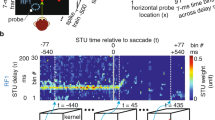Increases in the latent periods of memory-guided saccades as compared with those of visually guided saccades were observed, providing evidence of slowing in saccade programming based on extraction of information from working memory. Comparison of the parameters and topography of the N1 and P1 components of evoked potentials induced by a signal to perform a memory-guided saccade and a visual stimulus-guided saccade suggested that the early stages of saccade programming, associated with the processing of spatial information, are mediated mainly by the descending mechanism of attention for memory-guided saccades and the ascending mechanism for saccades in response to a visual stimulus. These data may indicate that the increase in the latent period of memory-guided saccades is associated with lengthening of the central stage of saccade programming – the decision-taking stage, a correlate of which is the N2 wave developing in the middle of the latent period of the memory-guided saccade. The temporospatial dynamics of the N1, P1, and N2 components provide evidence that memory-guided saccade programming is controlled by the fronto-medio-thalamic system of selective attention, as well as by left-hemisphere motor attention mechanisms.
Similar content being viewed by others
References
N. N. Bragina and T. A. Dobrokhotova, Functional Asymmetry in Humans [in Russian], Meditsina, Moscow (1988).
V. V. Gnezditskii, Evoked Brain Potentials in Clinical Practice [in Russian], MED press-inform, Moscow (2003).
A. M. Ivanitskii, “Brain potentials in mental operations of different levels of complexity,” Fiziol. Cheloveka, 15, No. 3, 11–19 (1989).
R. Näätänen, Attention and Brain Function [in Russian], Moscow State University Press, Moscow (1998).
M. V. Slavutskaya, V. V. Moiseeva, N. A. Fonsova, and V. V. Shulgovskii, “Human cortical initiation potentials preceding memory-guided saccades,” Zh. Vyssh. Nerv. Deyat., 60, No. 1, 12–21 (2010).
N. F. Suvorov and O. P. Tairov, Psychophysiological Mechanisms of Directed Attention [in Russian], Nauka. Leningrad (1985).
R. A. Andersen and J. W. Gnadt, “Posterior parietal cortex,” in: The Neurobiology of Saccadic Eye Movements, R. Wurts and M. Golberg (eds.), Elsevier Sci. Publ. BV (Biomedical Division), Amsterdam (1989), pp. 315–335.
W. Becker, “Saccadic eye movements as a control system,” ibid., pp. 361–390.
H. Boecker, A. Dagher,A. O. Ceballos-Baumann, R. E. Passingham, M. Samuel, K. J. Friston, J. B. Poline, C. Dettmers, B. Conrad, and D. J. Brooks, “Role of the human rostral supplementary motor area and basal ganglia in motor sequence control: investigation with H2 15O PET,” J. Neurophysiol., 79, 1070–1080 (1998).
I. Evdokimidis, N. Smirnis, T. S. Constantinidis, and C. Papageorgiou, “Fronto-parietal activation differences observed before the execution of remembered saccades: an event-related potential study,” Cogn. Brain Res., 12, 89–99 (2001).
R. Desimone and J. Duncan, “Neural mechanisms of selective visual attention,” Annu. Rev. Neurosci., 18, 193–222 (1995).
T. C. Gunter, A. A. Wiers, J. L. Jakson, and G. Mulder, “Visual spatial attention to stimuli presented on the vertical and horizontal meridian,” Psychophysiology, 31, 140–153 (1994).
J. C. Hauk and S. P. Wise, “Distributed modular architectures linking basal ganglia, cerebellum, and cerebral cortex: Their role in planning and controlling action,” Cereb. Cortex, 5, No. 2, 95–110 (1995).
O. Hikosaka,Y. Takikawa, and R. Kawagoe, “Role of the basal ganglia in the control purposive saccade eye movement,” Physiol. Rev., 80, 953–978 (2000).
M. Ibo and T. Sawaguchi, “Neuronal activity representing visual spatial mnemonic processes associated with target selection in the monkey dorsolateral prefrontal cortex,” Neurosci. Res., 43, 9–22 (2002).
M. Kinsbourne, “The cerebral basis of lateral asymmetrical in attention,” Acta Psychol., 33, 193–201 (1970).
B. S. Krishna, S. C. Stenrod, J. W. Bisley, J. B. Sirotin, and M. E. Goldberg, “Reaction time of manual responses to a visual stimulus at the goal of a planned memory-guided saccade in the monkey,” Exp. Brain Res., 173, 102–114 (2006).
E. K. Miller and J. D. Cohen, “An integrative theory of prefrontal cortex function,” Annu. Rev. Neurosci., 24, 167–202 (2001).
D. P. Munos and S. Everling, “Look away: the antisaccade task and the voluntary control of eye movement,” Nat. Rev. Neurosci., 5, 218–231 (2004).
C. Pierrot-Deseiligny, C. Milea, and R. M. Müri, “Eye movement control by cerebral cortex,” Curr. Opin. Neurol., 17, No. 1, 17–25 (2004).
K. H. Pribram and D. McGuinnes, “Arousal, activation, and effort in the control of attention,” Psychol. Rev., 82, 116–149 (1975).
P. Rämä, S. Carlsön, J. Kekoni, and H. Hämäläinen, “A spatial oculomotor memory-task performance produces a task-related slow shift in human encephalography,” EEG Clin. Neurophysiol., 94, 371–380 (1995).
J. Row, K. Friston, R. Frackowiak, and R. Passingmam, “Attention to action: Specific modulation of corticocortical interaction in humans,” Neuroimage, 17, 988–998 (2002).
M. F. S. Rushworth, P. D. Nixon, S. Renowden, D. T. Wade, and R. E. Passingham, “The left parietal cortex and motor attention,” Neuropsychologia, 35, 1261–1273 (1997).
M. Schlag-Rey and J. Schlag, “The central thalamus,” in: The Neurobiology of Saccadic Eye Movements, R. H. Wurts and M. E. Goldberg (eds.), Elsevier Sci. Publ. BV (Biomedical Division), Amsterdam (1989), pp. 361–390.
H. Shibasaki, G. Barret, E. Halliday, and A. Halliday, “Components of the movement-related cortical potential and their scalp topography,” EEG Clin. Neurophysiol., 4, 213–226 (1980).
D. Soto, D. Heinke, G. W. Humphreys, and M. J. Blanco, “Early, topdown guidance of attention from working memory,” J. Exp. Psychol. Hum. Percept. Perform., 31, No. 2, 248–261 (2005).
T. R. Stanford and D. L. Sparks, “Systematic errors for saccades to remembered target: evidence for a dissociation between saccades metrics and activity in the superior colliculus,” Vision Res., 34, 93–106 (1994).
Author information
Authors and Affiliations
Corresponding author
Additional information
Translated from Zhurnal Vysshei Nervnoi Deyatel’nosti imeni I. P. Pavlova, Vol. 60, No. 6, pp. 667–678, November–December, 2010.
Rights and permissions
About this article
Cite this article
Slavutskaya, M.V., Moiseeva, V.V. & Shulgovskii, V.V. Cortical Potentials Evoked in Humans by Signals to Perform Memory-Guided Saccades. Neurosci Behav Physi 42, 244–252 (2012). https://doi.org/10.1007/s11055-012-9559-1
Received:
Accepted:
Published:
Issue Date:
DOI: https://doi.org/10.1007/s11055-012-9559-1




